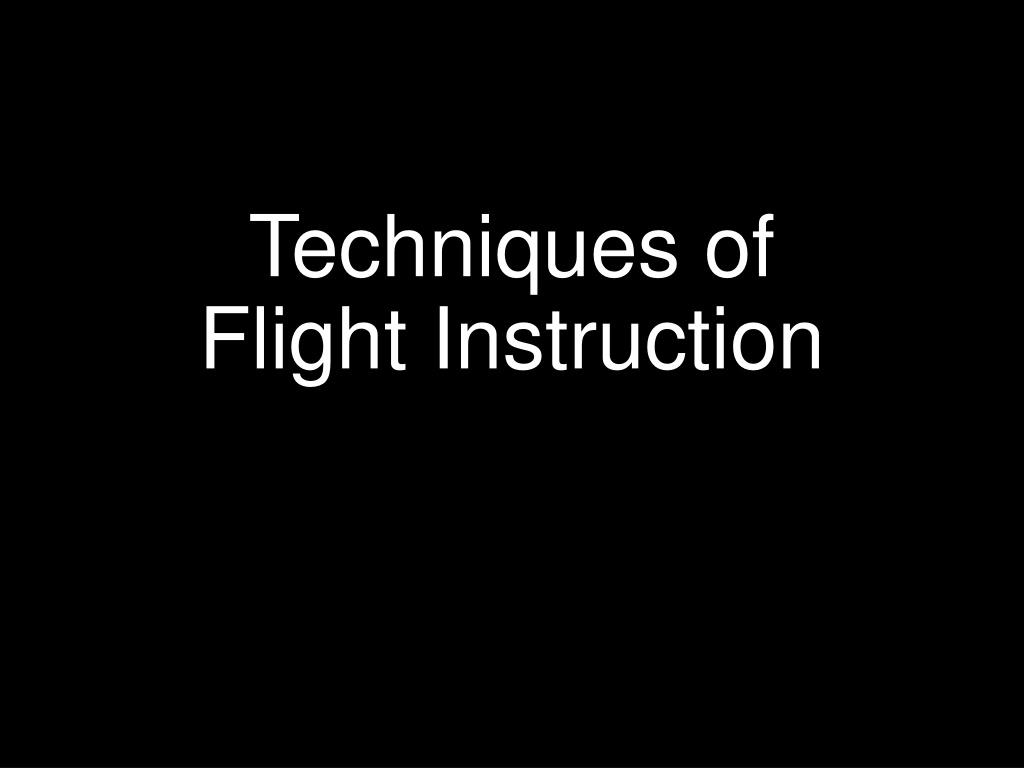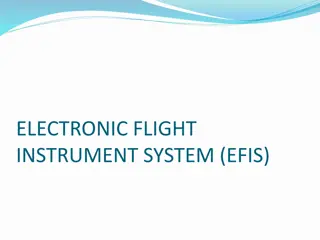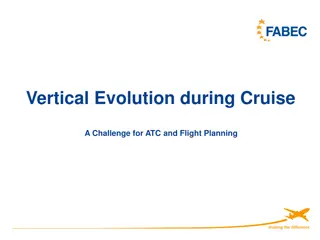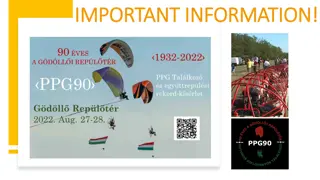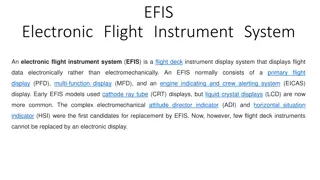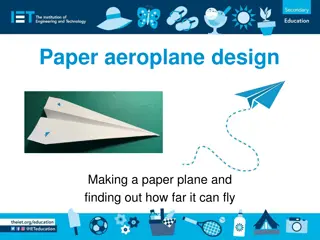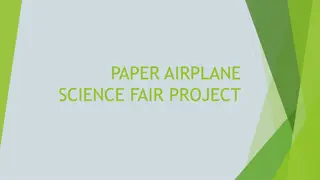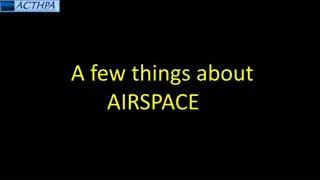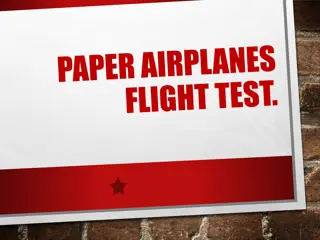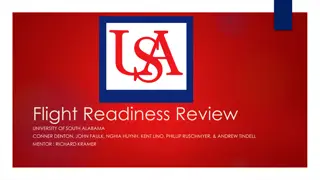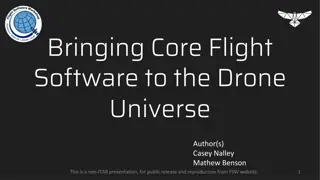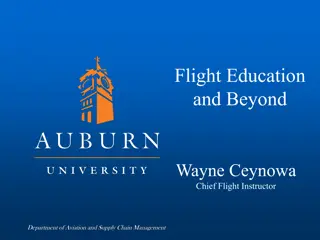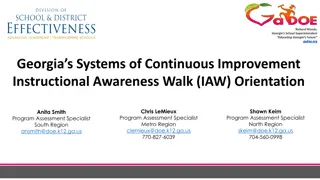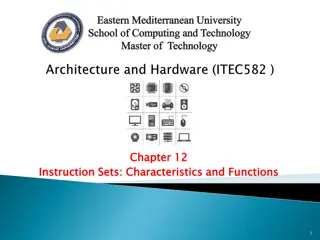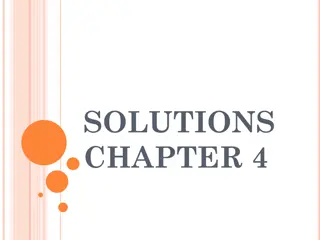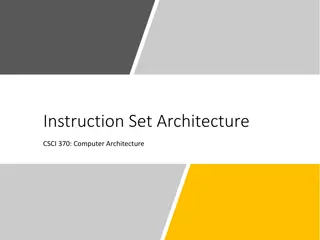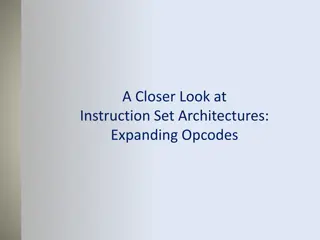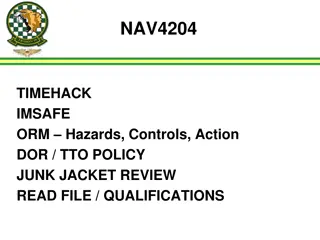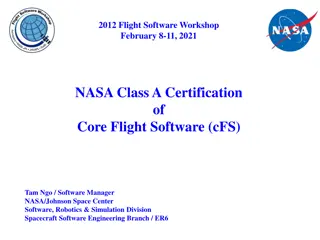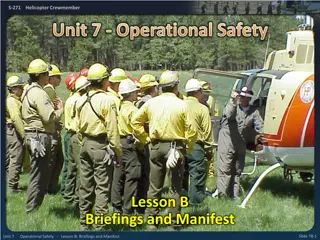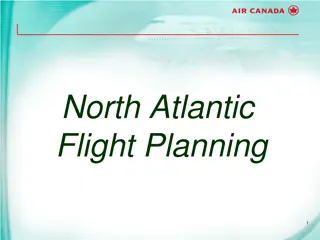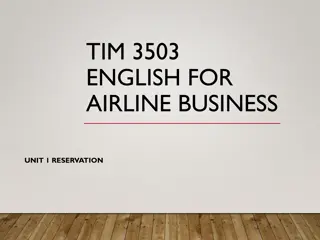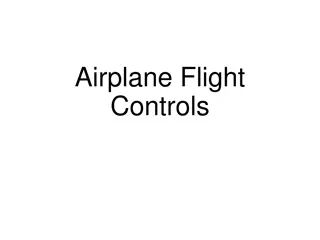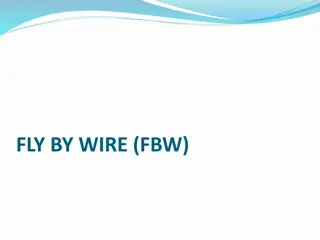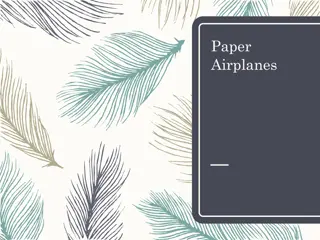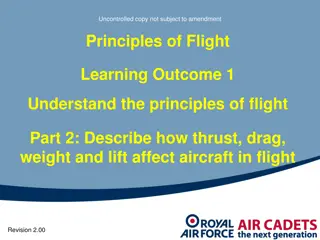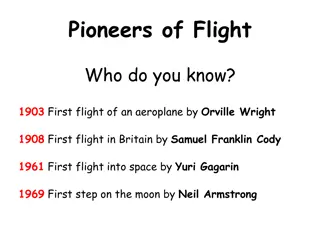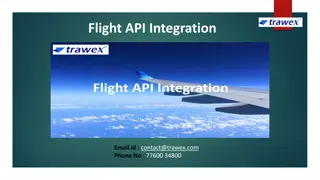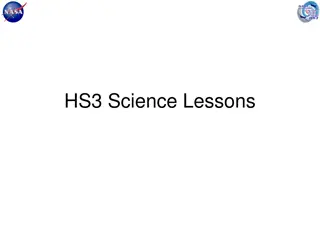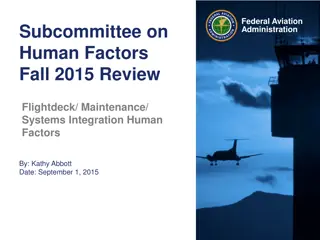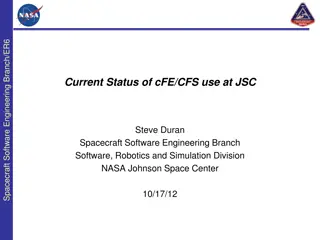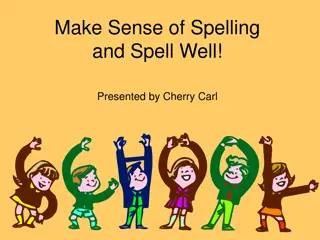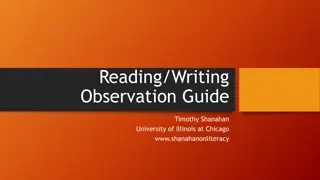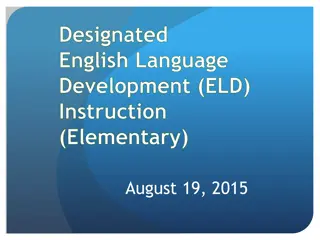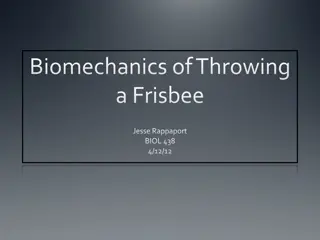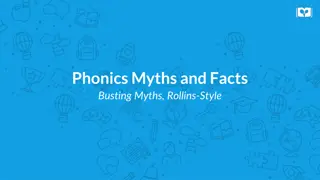Effective Techniques for Flight Instruction
Flight instructors play a crucial role in ensuring safe flying by addressing obstacles to learning, maintaining a positive exchange of controls, adhering to sterile cockpit rules, and utilizing integrated flight instruction methods. Inadequate training and unfair treatment can hinder student progress, but preliminary training with sub-goals and attention to student worries can enhance the learning experience. Encouraging student engagement and progress through achievable goals is vital for successful flight instruction.
Uploaded on Oct 06, 2024 | 0 Views
Download Presentation

Please find below an Image/Link to download the presentation.
The content on the website is provided AS IS for your information and personal use only. It may not be sold, licensed, or shared on other websites without obtaining consent from the author. Download presentation by click this link. If you encounter any issues during the download, it is possible that the publisher has removed the file from their server.
E N D
Presentation Transcript
Techniques of Flight Instruction
Flight instructors should encourage safe flying Obstacles to learning Demonstration-performance Positive exchange of flight controls Sterile cockpit rules Use of distractions Integrated flight instruction Assessment of piloting ability Aeronautical decision making
Inadequate instruction Obstacles to learning Obstacles to learning Unfair treatment Unfair treatment Impatience Impatience Efforts not considered and evaluated Worry/lack of interest Worry/lack of interest Physical discomfort Physical discomfort Apathy Apathy Unreasonable demands on performance/progress Anxiety Anxiety Demonstration Demonstration- -performance performance Decrease student motivation Positive exchange of controls Positive exchange of controls Sterile cockpit rules Sterile cockpit rules Students need attainable goals Use of distractions Use of distractions Integrated flight instruction Integrated flight instruction Assessment of piloting ability Assessment of piloting ability Aeronautical decision making Aeronautical decision making
Preliminary training is important Obstacles to learning Obstacles to learning Unfair treatment Unfair treatment Impatience Impatience Present training with sub-goals for each step Worry/lack of interest Worry/lack of interest Physical discomfort Physical discomfort Apathy Apathy Anxiety Anxiety Avoid unnecessary repetition Demonstration Demonstration- -performance performance Advance to next step as soon as goal is attained Positive exchange of controls Positive exchange of controls Sterile cockpit rules Sterile cockpit rules Use of distractions Use of distractions Integrated flight instruction Integrated flight instruction Assessment of piloting ability Assessment of piloting ability Aeronautical decision making Aeronautical decision making
Worried studentsnot ready to learn Obstacles to learning Obstacles to learning Unfair treatment Unfair treatment Impatience Impatience Don t ignore outside issues Use outside interests and enthusiasm Divert attention from worries Worry/lack of interest Worry/lack of interest Physical discomfort Physical discomfort Apathy Apathy Anxiety Anxiety Demonstration Demonstration- -performance performance Prevent flight training-related worries Keep students informed of progress and deficiencies Positive exchange of controls Positive exchange of controls Sterile cockpit rules Sterile cockpit rules Use of distractions Use of distractions Integrated flight instruction Integrated flight instruction Assessment of piloting ability Assessment of piloting ability Aeronautical decision making Aeronautical decision making
Slows rate of learning Obstacles to learning Obstacles to learning Unfair treatment Unfair treatment Impatience Impatience Airsickness Resistance develops early Keep students occupied to help Terminate flight Worry/lack of interest Worry/lack of interest Physical discomfort Physical discomfort Apathy Apathy Anxiety Anxiety Demonstration Demonstration- -performance performance Dehydration Reduces alertness Slows decision-making Positive exchange of controls Positive exchange of controls Sterile cockpit rules Sterile cockpit rules Use of distractions Use of distractions Heatstroke Inability of body to control its temperature Integrated flight instruction Integrated flight instruction Assessment of piloting ability Assessment of piloting ability Aeronautical decision making Aeronautical decision making
Fatigue may not be apparent to pilot until serious errors are made Obstacles to learning Obstacles to learning Unfair treatment Unfair treatment Impatience Impatience Worry/lack of interest Worry/lack of interest Physical discomfort Physical discomfort (normal occurrence) Acute fatigue Inattention Distractibility Errors in timing Neglect of secondary tasks Loss of accuracy/control Lack of awareness of error accumulation Irritability Apathy Apathy Anxiety Anxiety Demonstration Demonstration- -performance performance Positive exchange of controls Positive exchange of controls Sterile cockpit rules Sterile cockpit rules Use of distractions Use of distractions Integrated flight instruction Integrated flight instruction (lack of recovery) Chronic fatigue Not resolved by rest alone Can impair performance and affect pilot judgment/decision-making Assessment of piloting ability Assessment of piloting ability Aeronautical decision making Aeronautical decision making
Poorly organized instruction destroys student interest Obstacles to learning Obstacles to learning Unfair treatment Unfair treatment Impatience Impatience Worry/lack of interest Worry/lack of interest Provide well-planned, appropriate, and accurate instruction Physical discomfort Physical discomfort Apathy Apathy Anxiety Anxiety Demonstration Demonstration- -performance performance Teach for the level of the student Too elementary can t hold interest Too complicated can t evoke interest Positive exchange of controls Positive exchange of controls Sterile cockpit rules Sterile cockpit rules Use of distractions Use of distractions Integrated flight instruction Integrated flight instruction Assessment of piloting ability Assessment of piloting ability Aeronautical decision making Aeronautical decision making
Limits students perceptive ability Obstacles to learning Obstacles to learning Unfair treatment Unfair treatment Impatience Impatience Slows development of insights Worry/lack of interest Worry/lack of interest Physical discomfort Physical discomfort Apathy Apathy Provide comfortable atmosphere Confidence in instructor and airplane Anxiety Anxiety Demonstration Demonstration- -performance performance Positive exchange of controls Positive exchange of controls Sterile cockpit rules Sterile cockpit rules Use of distractions Use of distractions Integrated flight instruction Integrated flight instruction Assessment of piloting ability Assessment of piloting ability Aeronautical decision making Aeronautical decision making
Discussion of lesson objectives and completion standards, preflight briefing Obstacles to learning Obstacles to learning Demonstration Demonstration- -performance performance Explanation Explanation Base explanations on student s experience/knowledge Demonstration Demonstration Performance/Supervision Performance/Supervision Evaluation Evaluation Positive exchange of controls Positive exchange of controls Safety procedures Sterile cockpit rules Sterile cockpit rules Encourage students to ask questions Use of distractions Use of distractions Integrated flight instruction Integrated flight instruction Law of readiness Assessment of piloting ability Assessment of piloting ability Aeronautical decision making Aeronautical decision making
Show students necessary actions to perform a skill Obstacles to learning Obstacles to learning Demonstration Demonstration- -performance performance Explanation Explanation Avoid extraneous activity Demonstration Demonstration Performance/Supervision Performance/Supervision Evaluation Evaluation Law of primacy Positive exchange of controls Positive exchange of controls Sterile cockpit rules Sterile cockpit rules Use of distractions Use of distractions Integrated flight instruction Integrated flight instruction Assessment of piloting ability Assessment of piloting ability Aeronautical decision making Aeronautical decision making
Student practices to learn skill to reach established standards Obstacles to learning Obstacles to learning Demonstration Demonstration- -performance performance Explanation Explanation Instructor reviews and determines if student has met objectives Demonstration Demonstration Performance/Supervision Performance/Supervision Evaluation Evaluation Positive exchange of controls Positive exchange of controls Observe, then comment Sterile cockpit rules Sterile cockpit rules Use of distractions Use of distractions Integrated flight instruction Integrated flight instruction Assessment of piloting ability Assessment of piloting ability Aeronautical decision making Aeronautical decision making
Evaluate and record student performance Obstacles to learning Obstacles to learning Demonstration Demonstration- -performance performance Advise student of progress Explanation Explanation Demonstration Demonstration Performance/Supervision Performance/Supervision Point out areas that need improvement Offer suggestions Evaluation Evaluation Positive exchange of controls Positive exchange of controls Sterile cockpit rules Sterile cockpit rules Don t end evaluation on negative note Use of distractions Use of distractions Integrated flight instruction Integrated flight instruction Assessment of piloting ability Assessment of piloting ability Aeronautical decision making Aeronautical decision making
Critical during demo/performance Obstacles to learning Obstacles to learning Demonstration Demonstration- -performance performance Include procedures for exchange of flight controls in preflight briefing Three-way exchange Positive exchange of controls Positive exchange of controls Sterile cockpit rules Sterile cockpit rules Use of distractions Use of distractions Always guard controls and be prepared to take control Integrated flight instruction Integrated flight instruction Assessment of piloting ability Assessment of piloting ability Aeronautical decision making Aeronautical decision making
Critical phases of flight Ground ops/taxi Takeoff Landing All flight ops below 10,000 ft except cruise Obstacles to learning Obstacles to learning Demonstration Demonstration- -performance performance Positive exchange of controls Positive exchange of controls Sterile cockpit rules Sterile cockpit rules Reduce distractions Model behavior during instruction Use of distractions Use of distractions Integrated flight instruction Integrated flight instruction Assessment of piloting ability Assessment of piloting ability Aeronautical decision making Aeronautical decision making
Purposeto determine that the applicant can cope with distractions while maintaining aircraft control Obstacles to learning Obstacles to learning Demonstration Demonstration- -performance performance Positive exchange of controls Positive exchange of controls PIC must know when to tell passengers something is too distracting Including DPE Sterile cockpit rules Sterile cockpit rules Use of distractions Use of distractions Integrated flight instruction Integrated flight instruction Increased risk of entering inadvertent stall or spin Assessment of piloting ability Assessment of piloting ability Aeronautical decision making Aeronautical decision making
Maneuvers taught by outside visual references and reference to flight instruments Obstacles to learning Obstacles to learning Demonstration Demonstration- -performance performance Positive exchange of controls Positive exchange of controls Increases aircraft control and performance efficiency Sterile cockpit rules Sterile cockpit rules Use of distractions Use of distractions Integrated flight instruction Integrated flight instruction Does not mean student can handle IMC Procedures Procedures See and avoid See and avoid Assessment of piloting ability Assessment of piloting ability Aeronautical decision making Aeronautical decision making
Brief function of flight controls Obstacles to learning Obstacles to learning Demonstration Demonstration- -performance performance Expected outside and instrument references Positive exchange of controls Positive exchange of controls Sterile cockpit rules Sterile cockpit rules Use of distractions Use of distractions Integrated flight instruction Integrated flight instruction Procedures Procedures See and avoid See and avoid Assessment of piloting ability Assessment of piloting ability Aeronautical decision making Aeronautical decision making
Student needs to look for traffic at all times Obstacles to learning Obstacles to learning Demonstration Demonstration- -performance performance Develop habit from start of training Positive exchange of controls Positive exchange of controls Sterile cockpit rules Sterile cockpit rules Correct tendencies to enter maneuvers without checking for traffic Use of distractions Use of distractions Integrated flight instruction Integrated flight instruction Procedures Procedures Introduce right-of-way rules See and avoid See and avoid Assessment of piloting ability Assessment of piloting ability Aeronautical decision making Aeronautical decision making
Determines how the student is learning Obstacles to learning Obstacles to learning Demonstration Demonstration- -performance performance Provide student with something constructive Positive exchange of controls Positive exchange of controls Sterile cockpit rules Sterile cockpit rules Direction and guidance to raise level of performance Use of distractions Use of distractions Integrated flight instruction Integrated flight instruction Student must understand purpose of assessment Assessment of piloting ability Assessment of piloting ability Demonstrated ability Demonstrated ability Postflight Postflight evaluation evaluation First solo flight First solo flight Correction of errors Correction of errors Normal challenges Normal challenges Landings Landings Practical test recommendations Practical test recommendations Aeronautical decision making Aeronautical decision making
Based upon established standards of performance Modify to apply to student s experience Obstacles to learning Obstacles to learning Demonstration Demonstration- -performance performance Positive exchange of controls Positive exchange of controls Consider mastery of elements rather than overall performance Sterile cockpit rules Sterile cockpit rules Use of distractions Use of distractions Integrated flight instruction Integrated flight instruction Assessment of piloting ability Assessment of piloting ability Demonstrated ability Demonstrated ability Postflight Postflight evaluation evaluation First solo flight First solo flight Correction of errors Correction of errors Normal challenges Normal challenges Landings Landings Practical test recommendations Practical test recommendations Aeronautical decision making Aeronautical decision making
Keep student informed of progress At completion of maneuver, or summarized postflight Obstacles to learning Obstacles to learning Demonstration Demonstration- -performance performance Positive exchange of controls Positive exchange of controls Use written format Explain performance errors Point out deficient elements Suggest appropriate corrective measures Sterile cockpit rules Sterile cockpit rules Use of distractions Use of distractions Integrated flight instruction Integrated flight instruction Assessment of piloting ability Assessment of piloting ability Can use collaborative assessment Demonstrated ability Demonstrated ability Postflight Postflight evaluation evaluation First solo flight First solo flight Correction of errors Correction of errors Normal challenges Normal challenges Landings Landings Practical test recommendations Practical test recommendations Aeronautical decision making Aeronautical decision making
Provide guidance and restraint Student must demonstrate consistent ability to perform all fundamental maneuvers Obstacles to learning Obstacles to learning Demonstration Demonstration- -performance performance Positive exchange of controls Positive exchange of controls Sign-off Determine student is proficient in flight tasks necessary for flight Sterile cockpit rules Sterile cockpit rules Use of distractions Use of distractions Integrated flight instruction Integrated flight instruction Be present answer questions, resolve issues Assessment of piloting ability Assessment of piloting ability Demonstrated ability Demonstrated ability Postflight Postflight evaluation evaluation First solo flight First solo flight Consider scheduled time Correction of errors Correction of errors Normal challenges Normal challenges Landings Landings Practical test recommendations Practical test recommendations Aeronautical decision making Aeronautical decision making
Dont take controls away immediately Obstacles to learning Obstacles to learning Demonstration Demonstration- -performance performance Vary performance slightly, combine with other operations, apply same elements to other maneuvers Positive exchange of controls Positive exchange of controls Sterile cockpit rules Sterile cockpit rules Use of distractions Use of distractions Integrated flight instruction Integrated flight instruction Assessment of piloting ability Assessment of piloting ability Demonstrated ability Demonstrated ability Postflight Postflight evaluation evaluation First solo flight First solo flight Correction of errors Correction of errors Normal challenges Normal challenges Landings Landings Practical test recommendations Practical test recommendations Aeronautical decision making Aeronautical decision making
Teach student to solve problems Traffic pattern congestion Change in active runway Unexpected crosswinds Obstacles to learning Obstacles to learning Demonstration Demonstration- -performance performance Positive exchange of controls Positive exchange of controls Sterile cockpit rules Sterile cockpit rules Student visualizes flight under normal circumstances Use of distractions Use of distractions Integrated flight instruction Integrated flight instruction Instructor adds unforeseen circumstances and asks for reaction Realistic flying situations Assessment of piloting ability Assessment of piloting ability Demonstrated ability Demonstrated ability Postflight Postflight evaluation evaluation First solo flight First solo flight Correction of errors Correction of errors Check student s thought processes Normal challenges Normal challenges Landings Landings Practical test recommendations Practical test recommendations Aeronautical decision making Aeronautical decision making
Full stop landings Help student develop aircraft control Checklist usage Obstacles to learning Obstacles to learning Demonstration Demonstration- -performance performance Positive exchange of controls Positive exchange of controls Aircraft speed and control take precedence Sterile cockpit rules Sterile cockpit rules Use of distractions Use of distractions Land in first third of runway or go around Integrated flight instruction Integrated flight instruction Bounce go around Assessment of piloting ability Assessment of piloting ability Demonstrated ability Demonstrated ability Postflight Postflight evaluation evaluation First solo flight First solo flight Correction of errors Correction of errors Normal challenges Normal challenges Landings Landings Practical test recommendations Practical test recommendations Aeronautical decision making Aeronautical decision making
Require applicant to demonstrate thoroughly knowledge and skill level for certificate/rating Obstacles to learning Obstacles to learning Demonstration Demonstration- -performance performance Positive exchange of controls Positive exchange of controls Flight proficiency endorsement/IACRA signatures valid for 60 days Sterile cockpit rules Sterile cockpit rules Use of distractions Use of distractions Integrated flight instruction Integrated flight instruction Assessment of piloting ability Assessment of piloting ability Demonstrated ability Demonstrated ability Postflight Postflight evaluation evaluation First solo flight First solo flight Correction of errors Correction of errors Normal challenges Normal challenges Landings Landings Practical test recommendations Practical test recommendations Aeronautical decision making Aeronautical decision making
Teaching pilots to make sound decisions is the key to preventing accidents. Obstacles to learning Obstacles to learning Demonstration Demonstration- -performance performance ADM systematic approach to mental process used by pilots to consistently determine the best course of action in response to given set of circumstances Positive exchange of controls Positive exchange of controls Sterile cockpit rules Sterile cockpit rules Use of distractions Use of distractions Integrated flight instruction Integrated flight instruction Assessment of piloting ability Assessment of piloting ability Aeronautical decision making Aeronautical decision making Decision Decision- -making process making process Factors affecting decision Factors affecting decision- -making making Use of resources Use of resources
Teaching pilots to make sound decisions is the key to preventing accidents. Obstacles to learning Obstacles to learning Demonstration Demonstration- -performance performance Risk management decision-making process designed to systematically identify hazards, assess the degree of risk, and determine the best course of action associated with each flight Positive exchange of controls Positive exchange of controls Sterile cockpit rules Sterile cockpit rules Use of distractions Use of distractions Integrated flight instruction Integrated flight instruction Assessment of piloting ability Assessment of piloting ability Aeronautical decision making Aeronautical decision making Decision Decision- -making process making process Factors affecting decision Factors affecting decision- -making making Use of resources Use of resources
Teaching pilots to make sound decisions is the key to preventing accidents. Obstacles to learning Obstacles to learning Demonstration Demonstration- -performance performance Situational awareness accurate perception and understanding of all factors and conditions within four fundamental risk elements that affect safety before, during, and after the flight Positive exchange of controls Positive exchange of controls Sterile cockpit rules Sterile cockpit rules Use of distractions Use of distractions Integrated flight instruction Integrated flight instruction Assessment of piloting ability Assessment of piloting ability Aeronautical decision making Aeronautical decision making Decision Decision- -making process making process Factors affecting decision Factors affecting decision- -making making Use of resources Use of resources
Teaching pilots to make sound decisions is the key to preventing accidents. Obstacles to learning Obstacles to learning Demonstration Demonstration- -performance performance SRM the art and science of managing all resources available to a single pilot to ensure the successful outcome of the flight Positive exchange of controls Positive exchange of controls Sterile cockpit rules Sterile cockpit rules Use of distractions Use of distractions Integrated flight instruction Integrated flight instruction Assessment of piloting ability Assessment of piloting ability Aeronautical decision making Aeronautical decision making Decision Decision- -making process making process Factors affecting decision Factors affecting decision- -making making Use of resources Use of resources
Three step process Obstacles to learning Obstacles to learning Demonstration Demonstration- -performance performance 1. Define the problem Positive exchange of controls Positive exchange of controls Sterile cockpit rules Sterile cockpit rules 2. Choose the course of action Use of distractions Use of distractions Integrated flight instruction Integrated flight instruction 3. Implement the decision, evaluate the outcome Assessment of piloting ability Assessment of piloting ability Aeronautical decision making Aeronautical decision making Decision Decision- -making process making process Factors affecting decision Factors affecting decision- -making making Use of resources Use of resources
Three step process Obstacles to learning Obstacles to learning Demonstration Demonstration- -performance performance 1. Define the problem a. Recognize that a change has occurred b. Perceive problem (senses, insight, experience) Positive exchange of controls Positive exchange of controls Sterile cockpit rules Sterile cockpit rules Use of distractions Use of distractions Integrated flight instruction Integrated flight instruction 2. Choose the course of action Assessment of piloting ability Assessment of piloting ability 3. Implement the decision, evaluate the outcome Factors affecting decision- -making making Aeronautical decision making Aeronautical decision making Decision Decision- -making process making process Factors affecting decision Use of resources Use of resources
Three step process Obstacles to learning Obstacles to learning Demonstration Demonstration- -performance performance 1. Define the problem Positive exchange of controls Positive exchange of controls Sterile cockpit rules Sterile cockpit rules 2. Choose the course of action a. Evaluate need to react b. Determine actions that may be taken c. Consider expected outcome and assess risks Use of distractions Use of distractions Integrated flight instruction Integrated flight instruction Assessment of piloting ability Assessment of piloting ability Aeronautical decision making Aeronautical decision making 3. Implement the decision, evaluate the outcome Factors affecting decision- -making making Decision Decision- -making process making process Factors affecting decision Use of resources Use of resources
Three step process Obstacles to learning Obstacles to learning Demonstration Demonstration- -performance performance 1. Define the problem Positive exchange of controls Positive exchange of controls Sterile cockpit rules Sterile cockpit rules 2. Choose the course of action Use of distractions Use of distractions 3. Implement the decision, evaluate the outcome a. Determine how the decision can affect other phases of flight b. Continue to evaluate outcome to ensure it s producing the desired result Integrated flight instruction Integrated flight instruction Assessment of piloting ability Assessment of piloting ability Aeronautical decision making Aeronautical decision making Decision Decision- -making process making process Factors affecting decision Factors affecting decision- -making making Use of resources Use of resources
Hazardous attitudes Obstacles to learning Obstacles to learning Demonstration Demonstration- -performance performance Positive exchange of controls Positive exchange of controls Sterile cockpit rules Sterile cockpit rules Use of distractions Use of distractions Integrated flight instruction Integrated flight instruction Assessment of piloting ability Assessment of piloting ability Aeronautical decision making Aeronautical decision making Decision Decision- -making process making process Factors affecting decision Factors affecting decision- -making making Use of resources Use of resources
Stress Physical stress Physiological stress Psychological stress Obstacles to learning Obstacles to learning Demonstration Demonstration- -performance performance Positive exchange of controls Positive exchange of controls Sterile cockpit rules Sterile cockpit rules Can impair ability to make effective decisions in flight Use of distractions Use of distractions Integrated flight instruction Integrated flight instruction Assessment of piloting ability Assessment of piloting ability Aeronautical decision making Aeronautical decision making Decision Decision- -making process making process Factors affecting decision Factors affecting decision- -making making Use of resources Use of resources
Internal Ingenuity Knowledge Skill Understanding of equipment/systems Checklists POH/AFM Passengers Obstacles to learning Obstacles to learning Demonstration Demonstration- -performance performance Positive exchange of controls Positive exchange of controls Sterile cockpit rules Sterile cockpit rules Use of distractions Use of distractions Integrated flight instruction Integrated flight instruction External ATC AFSS making Assessment of piloting ability Assessment of piloting ability Aeronautical decision making Aeronautical decision making Decision Decision- -making process making process Factors affecting decision Factors affecting decision- -making Use of resources Use of resources Expose students to ATC Encourage them to take advantage of services
